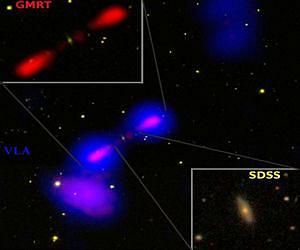
Optical SDSS image of the galaxies in yellow: Low resolution radio image from NVSS in blue; High resolution radio image from GMRT in red. Credit: Hota et al., SDSS, NCRA-TIFR, NRAO/AUI/NSF.
A galaxy with a combination of characteristics never seen before is giving astronomers a tantalizing peek at processes they believe played key roles in the growth of galaxies and clusters of galaxies early in the history of the Universe.
The galaxy, dubbed Speca by the researchers, is only the second spiral, as opposed to elliptical, galaxy known to produce large, powerful jets of subatomic particles moving at nearly the speed of light. It also is one of only two galaxies to show that such activity occurred in three separate episodes.
Giant jets of superfast particles are powered by supermassive black holes at the cores of galaxies. Both elliptical and spiral galaxies harbor such black holes, but only Speca and one other spiral galaxy have been seen to produce large jets. The jets pour outward from the poles of rapidly-rotating disks of material orbiting the black hole.
The on-and-off jet episodes have been seen in a dozen ellipticals, but only one other elliptical shows evidence, like Speca, for three such distinct episodes.
"This is probably the most exotic galaxy with a black hole ever seen. It has the potential to teach us new lessons about how galaxies and clusters of galaxies formed and developed into what we see today," said Ananda Hota, of the Academia Sinica Institute of Astronomy and Astrophysics (ASIAA), in Taiwan.
The scientists believe that Speca, about 1.7 billion light-years from Earth, and the 60-some other galaxies in a cluster with it are providing a look at what young galaxies and clusters may have been like when the Universe was much younger.
In the young Universe, galaxies in such clusters would have been gathering up additional material, colliding with each other, undergoing bursts of star formation, and interacting with primordial material falling into the cluster from outside.
"Speca is showing evidence for many of these phenomena," Ananda said, adding that "We hope to find many more galaxies like it with future observations, and to learn more about the processes and an environment that were much more common when the Universe was a fraction of its current age."
Speca (an acronym for Spiral-host Episodic radio galaxy tracing Cluster Accretion) first came to Ananda's attention in an image that combined data from the visible-light Sloan Digital Sky Survey and the FIRST survey done with the National Science Foundation's Very Large Array (VLA) radio telescope.
Followup observations with the Lulin optical telescope in Taiwan and ultraviolet data from NASA's GALEX satellite confirmed that the giant lobes of radio emission, usually seen coming from elliptical galaxies, were coming from a spiral galaxy with ongoing star formation.
Ananda's team also examined the galaxy in images from the NRAO VLA Sky Survey (NVSS), then made new observations with the Giant Meterwave Radio Telescope (GMRT) in India, which observes at longer wavelengths than the VLA and is the premier telescope for observing at those long wavelengths.
With this impressive variety of data from across the electromagnetic spectrum, the researchers unraveled the galaxy's complex and fascinating history.






No comments:
Post a Comment